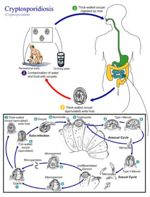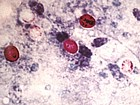Cryptosporidium
| This article is still under construction. |
| Cryptosporidium | |
|---|---|
| Kingdom | Protista |
| Phylum | Myzozoa |
| Class | Coccidea |
| Order | Eucoccidiorida |
| Family | Cryptosporidiidae |
| Genus | Cryptosporidium |
| Species | many |
Overview
Cryptosporidium is the single genus in the cryptosporidiidae family and contains at least 13 recognised species. These small protozoan parasites are able to infect a wide range of hosts including mammals, birds, reptiles and fish. These species are the causative agents of cryptosporidiosis, C. parvum is the most common species infecting mammals and man.
Recognition
Cryptosporidium species are extremely small in size, the oocysts being 4-5μm. They parasitise the epithelial cells lining the alimentary and respiratory tracts of the host. The developmental stages of the parasite are confined to the brush border area of the gut epithelium.
Life Cycle
Cryptosporidium mostly has a standard coccidial life cycle with a few exceptions. The oocyte does not contain sporocysts, instead the four sporozoites are free within the oocyst. The pre patent period of of cryptosporidium is 1 week, after which sporulated oocysts are shed in the hosts faeces.
Pathogenesis
In young calves Crytosporidium infection causes outbreak of sever diarrhoeaor scour. Contributes to undifferentiated neonatal calf diarrhoea which is a mixed viral enteritis in calves. Although it can cause severe illness in young animals, many older animals can be asymptomatic carriers of the disease.
Cryptosporidium is a zoonotic disease that can infect humans causing severe vomiting and diarrhoea. This is commonly seen in people who work with animals and do not practice sufficient hygiene and in AIDS and other immunocompromised patients.
Epidemiology
- Direct faecal-oral infection
- E.g. School parties visiting farms
- Water-borne infection
- E.g. contaminated water supply may infect hundreds of people
- Difficult to locate source
Diagnosis
- Faecal smear
- Ziehl-Neelson (ZN) stain
- Oocysts stain red against a blue/green background
- Immunoassays
- Detect oocysts in faeces
Control
- Isolate/quarantine bought-in calves
- Treat if signs of diarrhoea present
- Good hygiene, adequate bedding and disinfection of calf pens is important
- Prevention/treatment
- Halofuginone
- Halocur or Intervet
- Oral dosage
- Halofuginone
Villus Atrophy in Enteritis
- Affects calf, lamb, piglet, kitten.
- Increasingly important as part of the neonatal diarrhoea complex in calves.
- Zoonosis.
Pathology
Gross
- Intestines diffusely reddened, with fluid contents.
Histological
- Tiny parasites on surface of epithelium.
- Villus atrophy and fusion.
- Iinflammation (mainly lymphoid) in crypts and lamina propria.




